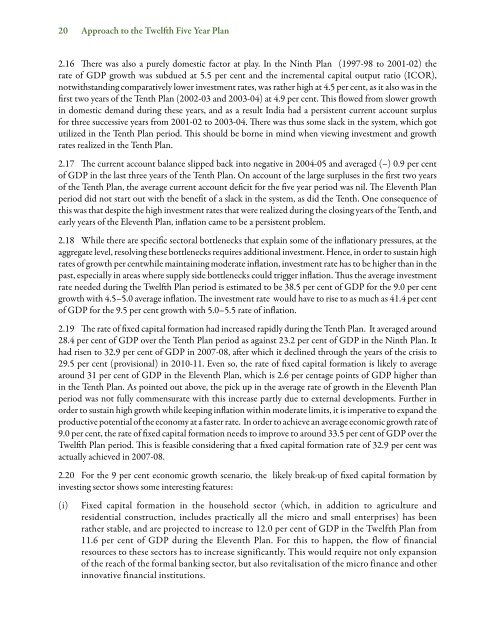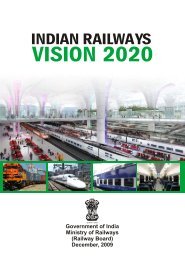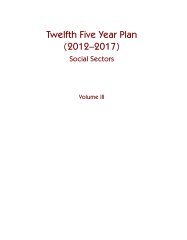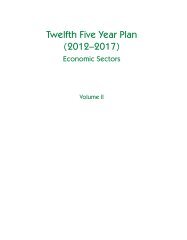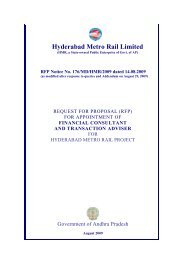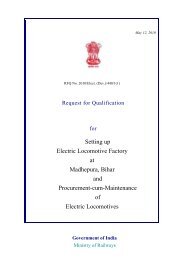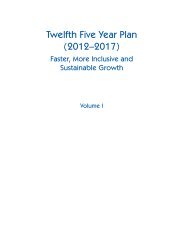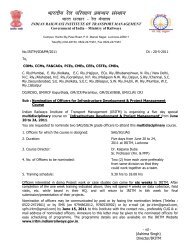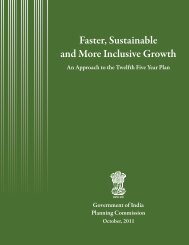Approach 12 FYP - Indian Railways Institute of Transport Management
Approach 12 FYP - Indian Railways Institute of Transport Management
Approach 12 FYP - Indian Railways Institute of Transport Management
You also want an ePaper? Increase the reach of your titles
YUMPU automatically turns print PDFs into web optimized ePapers that Google loves.
20 <strong>Approach</strong> to the Twelfth Five Year Plan<br />
2.16 There was also a purely domestic factor at play. In the Ninth Plan (1997-98 to 2001-02) the<br />
rate <strong>of</strong> GDP growth was subdued at 5.5 per cent and the incremental capital output ratio (ICOR),<br />
notwithstanding comparatively lower investment rates, was rather high at 4.5 per cent, as it also was in the<br />
first two years <strong>of</strong> the Tenth Plan (2002-03 and 2003-04) at 4.9 per cent. This flowed from slower growth<br />
in domestic demand during these years, and as a result India had a persistent current account surplus<br />
for three successive years from 2001-02 to 2003-04. There was thus some slack in the system, which got<br />
utilized in the Tenth Plan period. This should be borne in mind when viewing investment and growth<br />
rates realized in the Tenth Plan.<br />
2.17 The current account balance slipped back into negative in 2004-05 and averaged (–) 0.9 per cent<br />
<strong>of</strong> GDP in the last three years <strong>of</strong> the Tenth Plan. On account <strong>of</strong> the large surpluses in the first two years<br />
<strong>of</strong> the Tenth Plan, the average current account deficit for the five year period was nil. The Eleventh Plan<br />
period did not start out with the benefit <strong>of</strong> a slack in the system, as did the Tenth. One consequence <strong>of</strong><br />
this was that despite the high investment rates that were realized during the closing years <strong>of</strong> the Tenth, and<br />
early years <strong>of</strong> the Eleventh Plan, inflation came to be a persistent problem.<br />
2.18 While there are specific sectoral bottlenecks that explain some <strong>of</strong> the inflationary pressures, at the<br />
aggregate level, resolving these bottlenecks requires additional investment. Hence, in order to sustain high<br />
rates <strong>of</strong> growth per centwhile maintaining moderate inflation, investment rate has to be higher than in the<br />
past, especially in areas where supply side bottlenecks could trigger inflation. Thus the average investment<br />
rate needed during the Twelfth Plan period is estimated to be 38.5 per cent <strong>of</strong> GDP for the 9.0 per cent<br />
growth with 4.5–5.0 average inflation. The investment rate would have to rise to as much as 41.4 per cent<br />
<strong>of</strong> GDP for the 9.5 per cent growth with 5.0–5.5 rate <strong>of</strong> inflation.<br />
2.19 The rate <strong>of</strong> fixed capital formation had increased rapidly during the Tenth Plan. It averaged around<br />
28.4 per cent <strong>of</strong> GDP over the Tenth Plan period as against 23.2 per cent <strong>of</strong> GDP in the Ninth Plan. It<br />
had risen to 32.9 per cent <strong>of</strong> GDP in 2007-08, after which it declined through the years <strong>of</strong> the crisis to<br />
29.5 per cent (provisional) in 2010-11. Even so, the rate <strong>of</strong> fixed capital formation is likely to average<br />
around 31 per cent <strong>of</strong> GDP in the Eleventh Plan, which is 2.6 per centage points <strong>of</strong> GDP higher than<br />
in the Tenth Plan. As pointed out above, the pick up in the average rate <strong>of</strong> growth in the Eleventh Plan<br />
period was not fully commensurate with this increase partly due to external developments. Further in<br />
order to sustain high growth while keeping inflation within moderate limits, it is imperative to expand the<br />
productive potential <strong>of</strong> the economy at a faster rate. In order to achieve an average economic growth rate <strong>of</strong><br />
9.0 per cent, the rate <strong>of</strong> fixed capital formation needs to improve to around 33.5 per cent <strong>of</strong> GDP over the<br />
Twelfth Plan period. This is feasible considering that a fixed capital formation rate <strong>of</strong> 32.9 per cent was<br />
actually achieved in 2007-08.<br />
2.20 For the 9 per cent economic growth scenario, the likely break-up <strong>of</strong> fixed capital formation by<br />
investing sector shows some interesting features:<br />
(i)<br />
Fixed capital formation in the household sector (which, in addition to agriculture and<br />
residential construction, includes practically all the micro and small enterprises) has been<br />
rather stable, and are projected to increase to <strong>12</strong>.0 per cent <strong>of</strong> GDP in the Twelfth Plan from<br />
11.6 per cent <strong>of</strong> GDP during the Eleventh Plan. For this to happen, the flow <strong>of</strong> financial<br />
resources to these sectors has to increase significantly. This would require not only expansion<br />
<strong>of</strong> the reach <strong>of</strong> the formal banking sector, but also revitalisation <strong>of</strong> the micro finance and other<br />
innovative financial institutions.


